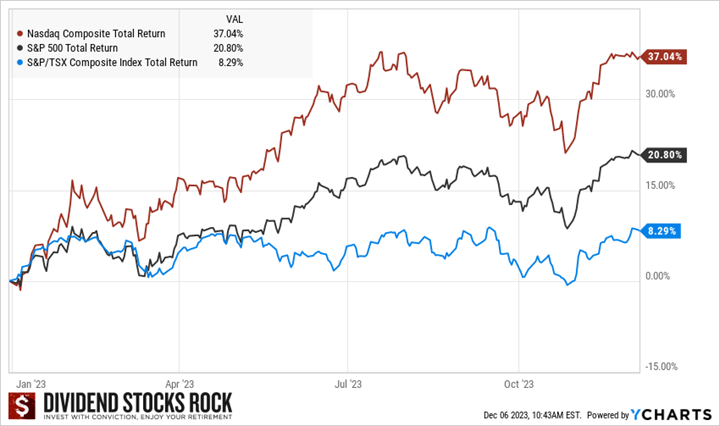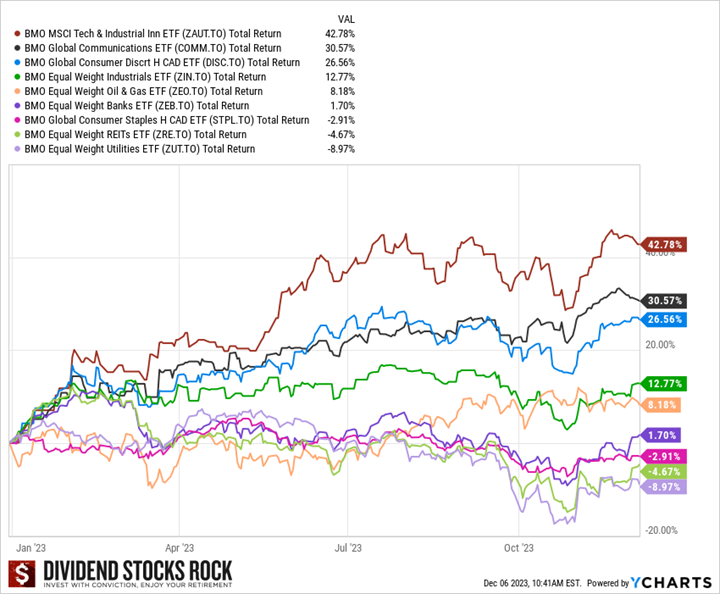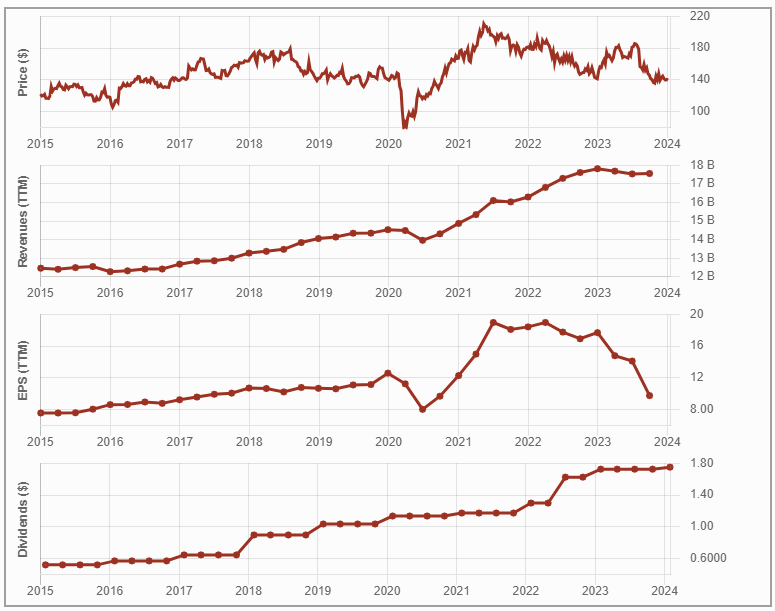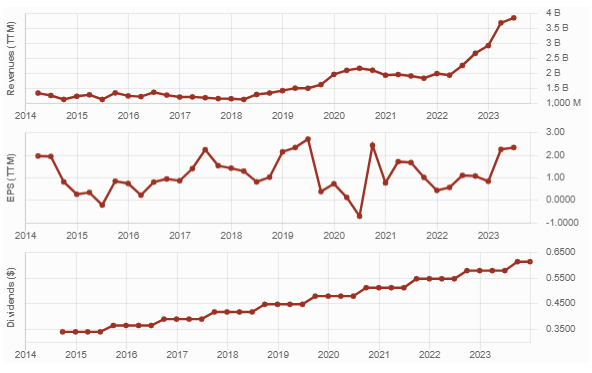Best Income Stocks 2024 – Part 2 [Podcast]
February 07, 2024
best high yield stocks 2024, best high-yield stocks, best income stocks, blog, Canadian Bank stocks, CNQ stock, dividend ideas for income, Granite REIT stock, Great-West Lifeso, GRT UN TO stock, GWO.TO Stock, high dividend stocks, income stocks to buy, income-seeking investors, LIF stock, LIF.TO stock, Podcast, safe income stocks to buy, SLF.TO Stock, Sun Life stock, Telus stock
0 Comment
Subscribe
What are the Best Income Stocks in Canada? This is what we’ll cover in this part 2! After a few words about high yielders, we’ll investigate 8 companies in 5 sectors. Which one is on your buy list?
Looking for more ideas? We have a Top Stocks for 2024 Booklet with three sectors review and 6 more stock ideas for you!
You’ll Learn
- Let’s start by reminding ourselves why a company pays a low or a high yield.
- Bear markets can impact yields. How does Mike analyze higher yields of solid companies in a bear market?
- As seen last week, the REIT sector is good for finding income stocks as they must distribute most of their income. In Canada, Granite REIT (GRT.UN.TO) certainly deserves its place on a Best Income Stocks list despite the sector’s more challenging times.
- That said, Granite still relies a lot on Magna International. Is that its main downside?
- The next stock pick is in the material sector, which has been hit hard in the last two years. Labrador Iron Ore (LIF.TO) has reported a bad Q4. Why does Mike think it remains solid?
- LIF currently pays a yield of over 7%. At what point does it become riskier? What should investors follow closely?
- Now, communication services, especially telecoms, are an excellent place to find income stocks in Canada. Mike’s favorite is Telus (T.TO) once more. But why does he like it so much?
- Telus’s price was on a downward trend in 2023. How can we explain this fact, and should investors be worried?
- Mike is not a big fan of the Energy sector but still picked one company: Canadian Natural Resources (CNQ.TO). Its incredibly stable business makes it an exciting play.
- The last picks are all in the Financial Services sector. Why do we find so many income stocks in this sector?
- Mike selected Great-West Lifeco (GWO.TO) and Sun Life Financial (SLF.TO) over Manulife in the insurance companies. Their growth vectors make them better candidates for the long haul.
- Let’s end with a few words on Canadian Banks. They currently offer high yields, which makes them more attractive to income-seeking investors. Are high yields there to stay for banks?
- We already know that Royal Bank and National Bank are Mike’s favorites. Are they the best opportunities for income stocks?
Related Content
Missed part one on the Best US Income Stocks? Search no more; listen below!
Best Income Stocks 2024 – Part 1 [Podcast]
Here is the Q4-2023 Bank Earnings Review! Make sure to subscribe to our YouTube Channel so you don’t miss the next Banks update!
Subscribe
The Best Dividends to Your Inbox!
Download our Dividend Rock Star List now and do not miss out on the good stuff! Receive our Portfolio Workbook and weekly emails, including our latest podcast episode!
Follow Mike, The Dividend Guy, on:
- YouTube
Have Ideas?
If you have ideas for guests, topics for The Dividend Guy Blog podcast, or simply to say hello, then shoot me an email.
This podcast episode has been provided by Dividend Stocks Rock.

The post Best Income Stocks 2024 – Part 2 [Podcast] appeared first on The Dividend Guy Blog.
Why Not Simply Invest in ETFs?
February 01, 2024
This question comes up often. Why not simply invest in ETFs? After all, they offer instant diversification and convenience. However, as a firm believer in the power of dividend growth investing, I stay away from ETFs, and I’ll explain why.
See some of our dividend stock selection for 2024, download our Top Stocks booklet now!
I truly believe there are multiple ways for investors to be successful on the market. Investing in ETFs is a perfectly valid strategy that has serious advantages over any stock picking strategy. It’s much easier and requires less time. There are myriads of ETFs to choose from.
You can buy index ETFs that aim to replicate the performance of a specific index, such as the S&P 500, Nasdaq 100, or FTSE 100. There are non-index ETFs that focus on specific sectors (e.g., technology, healthcare), regions (e.g., emerging markets), or investment strategies (e.g., dividend, covered calls). Fund managers actively make investment decisions for non-index ETFs with the goal of outperforming a benchmark or achieving a specific investment goal.
However, ETFs come with drawbacks that don’t suit me. I believe that investing directly in dividend growing equities provides me with better total returns. Here’s why…
Lack of control on stock selection
 By buying an ETF, I relinquish the ability to handpick individual stocks. I can choose which index or sector I want to replicate, even choose an investing goal, be it growth or dividends, but not the individual stocks. I’m basically buying a basket of stocks picked for me based on metrics or a philosophy that may not be entirely mine. In other words; I’m not investing according to my strategy but according to someone else’s.
By buying an ETF, I relinquish the ability to handpick individual stocks. I can choose which index or sector I want to replicate, even choose an investing goal, be it growth or dividends, but not the individual stocks. I’m basically buying a basket of stocks picked for me based on metrics or a philosophy that may not be entirely mine. In other words; I’m not investing according to my strategy but according to someone else’s.
Buying undesirable companies
When I look at the composition of ETFs, most of them include stocks that I really don’t like and that I would never pick. ETFs often include high and low-quality stocks within a particular index or sector, diluting the overall quality of the portfolio.
For example, over 15% of the BMO equal weight banks Index ETF (ZEB.TO) is invested in Scotia Bank, my least favorite of the big Canadian banks. The top ten holdings of its US Dividend ETF (ZDY.TO) include IBM and Verizon, two companies that are less than thriving, and for which there are much better alternatives. I chose BMO ETFs as examples here, but I would find similar problems in BlackRock’s iShares ETFs and others.
Investing in dividend growers helps me to limit my stock basket so that it includes only companies that show favorable factors. Why would I bother investing in index ETFs that takes all the great businesses and all the weak ones at the same time?
Hidden cost of ETFs eroding returns
 While ETFs are often praised for their low expense ratios, even a seemingly modest fee can significantly erode the compounding effect of dividend reinvestment over the long term.
While ETFs are often praised for their low expense ratios, even a seemingly modest fee can significantly erode the compounding effect of dividend reinvestment over the long term.
The popular notion that index ETFs are an easy avenue for beating the market is, in my view, somewhat misleading. Mirroring the market’s performance becomes much more difficult when you factor in these fees. In essence, by investing in an index ETF, I’m willingly sacrificing a portion of my returns. Therefore, it’s virtually impossible to beat a benchmark with index investing; investors are eternally behind it by a small margin.
Insufficient management and adjustments
Another drawback I find with many ETFs is a lack of active management. Some ETFs merely replicate the composition of an index without adjusting for changing market conditions or individual company performance.
As a dividend growth investor, my quarterly reviews of my portfolio reveal when earnings are slowing in their growth or falling, or when there isn’t any dividend growth. This active management allows me to make informed decisions about when to dig for more information, buy, hold, or sell a stock based on the company’s fundamental health and ability to sustain dividend growth. ETFs often hold on to positions despite worsening company fundamentals.
See some of our dividend stock selection for 2024, download our Top Stocks booklet now!
What about dividend ETFs?
Investors might want to adopt a simplified dividend growth investing strategy by choosing dividend ETFs, rather than individual equities. From what I can see, most dividend-focused ETFs are built based on stocks of companies that are dividend aristocrats, or on a specific yield or dividend growth target.
There’s more to dividend growth investing than yield and dividend growth metrics. Metrics only tell us about the company’s past, not much about what is coming. To assess a company’s ability to keep growing its dividend, you must look at graphs to see trends, read quarterly earnings and annual reports to see where the company’s going and how it can sustain its growth. You’ll only find this level of scrutiny in very actively managed ETFs.
The takeaway
You can spend a lot of time reading research that tells you index investing is better than dividend growth investing, or the opposite.
- Does ETF investing work? Yes
- Does index investing work? Yes.
- Does dividend growth investing work? Definitely YES
What you really must do is build your own investing process. Find out what really works for you and stick to it.
ETFs offer diversification and are the best vehicle if you want a simple way to invest in the stock market. Simply buy something that tracks the S&P 500, the TSX, and the MCSI and you’ll do just fine. Things get more complicated if you try to track specific sectors or investment strategies with ETFs, which is why I will continue my journey with dividend growth investing.
The post Why Not Simply Invest in ETFs? appeared first on The Dividend Guy Blog.
Best Income Stocks 2024 – Part 1 [Podcast]
January 31, 2024
ABBV stock, BAM stock, BEP stock, BEPC stock, best high yield stocks 2024, best high-yield stocks, best income stocks, best income stocks 2024, BIP stock, BIPC stock, blog, dividend ideas for income, high dividend stocks, income-seeking investors, PFE stock, Podcast, Realty Income stock, safe income stocks to buy, VICI stock
Subscribe
Looking for income? We’ve got you covered! In this part one of the Best Dividend Income Stocks for 2024, we’ll discuss the pros and cons of 7 companies in 4 different sectors.
Looking for more ideas? We have a Top Stocks for 2024 Booklet with three sectors review and 6 more stock ideas for you!
You’ll Learn
- First, let’s describe what a safe income dividend stock is to Mike and his criteria for selecting them.
- It seems easier to find high yields in Canada than in the US. Mike gives us an explanation.
- The REIT sector is normally good for finding income stocks as they must distribute most of their income. In the US, we can think of Vici Properties (VICI). VICI is a triple-net lease REIT focused on Casinos. Its stable business model ensures it has a place on our list.
- But with all the economic uncertainties, isn’t buying a REIT based on leisure and spending riskier? What other potential downsides face VICI?
- Another REIT worth mentioning is Realty Income (O), a highly diversified REIT in terms of tenants, industries, geographies, and property types. This classic income play REIT shows an occupancy rate of 99%!
- Realty Income is among the five REIT members of the S&P High Yield Dividend Aristocrats. However, investors should expect little capital appreciation. Why is it so?
- The healthcare sector also shows some of the best income stocks on the market. Why are healthcare stocks actually showing higher dividend yields?
- Among our list is Pfizer (PFE). Mike describes his investment thesis for this one, relying on international sales and recent acquisitions.
- Many investors were concerned about PFE in 2023 as its stock price greatly declined. Is Mike worried about it, and what should investors expect in the short term compared to the long term?
- Another company part of our Best Income Stocks list is AbbVie (ABBV), a dividend aristocrat. ABBV added new drugs to its pipeline, which makes it more diversified.
- As is often the case with healthcare companies, patent renewals can significantly affect AbbVie’s results. What else should we be aware of?
- We end with some of the Brookfield companies. These Canadian companies trade on the US market and pay their dividends in US dollars. Mike discusses Brookfield Asset Management (BAM), Brookfield Infrastructure (BIP), and Brookfield Renewable (BEP).
- Why should investors select these utilities instead of pure American plays?
Related Content
You can download the Brookfield Family Report for free below. Also, follow Newcomer Investor, the #1 fan of Brookfield Stocks!
Many factors will influence the market in 2024, some for good, others for worse. Knowing about them helps you understand your results and make better choices for your portfolio.
Investment Themes and Playbook for 2024 [Podcast]
Dividend Deluxe Bonds normally fall into the high-yield stocks. However, to be classified as a deluxe bond, they need more qualities than that… Learn how to differentiate dividend deluxe bonds from dividend traps!
What are Dividend Deluxe Bonds and Do You Need Them? [Podcast]
Subscribe
The Best Dividends to Your Inbox!
Download our Dividend Rock Star List now and do not miss out on the good stuff! Receive our Portfolio Workbook and weekly emails, including our latest podcast episode!
Follow Mike, The Dividend Guy, on:
- YouTube
Have Ideas?
If you have ideas for guests, topics for The Dividend Guy Blog podcast, or simply to say hello, then shoot me an email.
This podcast episode has been provided by Dividend Stocks Rock.

The post Best Income Stocks 2024 – Part 1 [Podcast] appeared first on The Dividend Guy Blog.
Investment Themes and Playbook for 2024 [Podcast]
January 24, 2024
AI stocks 2024, blog, bond rally 2024, earnings expectations 2024, factors impact stock market, Factors that can affect stock prices, Factors That Move Stock Prices Up and Down, interest rates cuts 2024, investment playbook 2024, investment themes 2024, investment themes for 2024, market noise 2024, Podcast, recession 2024, renewable energy 2024, zombie companies
Subscribe
Many factors will influence the market in 2024, some for good, others for worse. While the goal is not to change your entire investment plan, knowing about them helps you understand your results and make better choices for your portfolio.
Looking to add holdings to your portfolio? We have a Top Stocks for 2024 Booklet with three sectors review and 6 different stock ideas for you!
You’ll Learn
- We started 2023 with the fear of more interest rate hikes and continued inflation. These themes didn’t pass throughout the year… until the end of the year! Many experts predicted more increases, and now we expect cuts!
- Mike warned us about an upcoming recession at the beginning of 2023… which is not officially there yet. Will we be able to reach the smooth lending hoped for?
- However, big retailers have added words of caution about their customers being reluctant. Should investors expect lower earnings in 2024?
- What are Zombie Companies and how can they impact the stock market?
- In 2023, many investors left the stock market boat or waited to invest. According to Morningstar, at least $6 trillion is sitting in cash on the sidelines. What could this lead to?
- Some people also switched strategies to income products like bonds. This will create a bond rally, but is it a long-term play?
- Artificial intelligence has been a trendy word in 2023. Is it the solution to cost savings in 2024? And how can this impact investors?
- It has been a rollercoaster for renewable energy over the past two years. Will it continue and what is the long-term perspective for the industry?
- Can war and political tensions affect an investment portfolio this year?
Related Content
Got some cash waiting on the side? Mike did an entire YouTube series on How to Invest a Lump Sum of Money. Watch it below!
How do you invest in AI at low risk? Here’s how many good dividend growers can be part of this new era without adding too much hazard to your portfolio.
Stocks to Benefit from the AI Trend – Is It Relevant? [Podcast]
Have you missed our January 1st to January 5th episodes? No worries, here’s the full series for you to be fully caught up on the good stuff!
How to Invest in 2024 [Podcast Series]
Subscribe
The Best Dividends to Your Inbox!
Download our Dividend Rock Star List now and do not miss out on the good stuff! Receive our Portfolio Workbook and weekly emails, including our latest podcast episode!
Follow Mike, The Dividend Guy, on:
- YouTube
Have Ideas?
If you have ideas for guests, topics for The Dividend Guy Blog podcast, or simply to say hello, then shoot me an email.
This podcast episode has been provided by Dividend Stocks Rock.

The post Investment Themes and Playbook for 2024 [Podcast] appeared first on The Dividend Guy Blog.
Best Canadian Dividend Stocks for 2024
January 23, 2024
2024: best Canadian dividend stocks, best canadian dividends, best canadian stocks, best dividend 2024, blog, canadian dividend ideas, Canadian Dividend Stocks, Canadian Tire stock, Capital power stock, CPX TO Stock, CTC.A.TO Stock, Dividend Growth, top canadian dividend, top canadian stocks, top canadian stocks 2024, top dividend stocks, top dividend stocks 2024, top stocks 2024, what to hold in 2024
What are some of best canadian dividend stocks for 2024? After the eventful year that was 2023, it’s confusing to say the least.
Depending on which sectors and markets you were invested in in 2023, you either had a great year or saw your portfolio value decline. As you can see in the graph below, the technology sector dominated the market, but mostly due to a very few big players. The U.S. market outperformed the Canadian market by a wide margin.

In Canada, the energy sector performed better than in the U.S. with +8.18% compared to -2.57%. While the following graph shows the technology, communications, and consumer discretionary ETFs leading the way, take with a grain of salt it shows BMO ETFs that each include several U.S. stocks. Banks and telecommunications companies disappointed in 2023 as did utilities and REITs.

What’s next?
We live in a strange world: inflation hurts consumers’ budgets forcing them to tighten their belt with high interest rates putting even more pressure on them and yet, the unemployment rate remains low because of our aging population.
In the second half of 2023, we saw signs that higher interest rates were finally catching up with the economy and slowing it down. Inflation has lowered, GDP isn’t as strong (Canada even reported a negative GDP late in 2023) and unemployment rates on both sides of the border are going up by a bit.
New inflation data hints at a pause in interest rates. We might even talk about rate decreases later in 2024. However, we won’t see 2% mortgages or debentures in 2024. Companies will have to deal with higher interest rates when refinancing. We’ll continue to feel the lagging impact of those interest rate increases for many years.
If you focus on your portfolio yield, you were unhappy with your results in 2023 and my guess is that it won’t be easy in 2024 either.
That said, the secret is stay loyal to an investment strategy that works for you. For me, that strategy is to invest in dividend growers that I have researched well and in which I am very confident. That helps me to not panic on every whim of the market or each bit of bad news about the economy.
A full podcast series on How to Invest 2024 is available to you now! Get your plan for the year ready!
Find out about 6 companies that will crush 2024

I compile a list of stocks expected to do better than the market for Dividend Stocks Rock members each year. This year, I’ve reviewed the 11 sectors for them and included top picks for each. I’ve decided to share three of them with you: Consumer Discretionary, Financials, and Industrials.
You can download 6 of my top 24 for 2024 right here:
Today, I share with you two stocks that are among my Top Picks for 2024. The selection methodology of those companies is explained in this article:
What a Dividend Growth Investor Buys in 2024?
Canadian Tire (CTC.A.TO)
- Market cap: $8B
- Yield: 4.85%
- Revenue growth (5yr, annualized): 6.05%
- EPS growth rate ((5yr, annualized): 10.53%
- Dividend growth rate (5yr, annualized): 17.61%

In an effort to beat the market, I have to take my chances with another iconic brand showing price weakness. Canadian Tire currently trades at a forward PE of 10. For the record, the past 5-year PE average is nearly 12. EPS has been on a downtrend as margins are under pressure and the company faces fierce competition.
However, its focus on “home brands” should help margins to expand. Canadian Tire invested massively in its e-commerce platform and uses its store network for pick-ups increasing its digital sales. Again, it’s really an “educated guess”. I expect a choppy year for CTC.A.TO, because we never really know when the rebound will happen.

Capital Power (CPX.TO)
- Market cap: $5B
- Yield: 6.78%
- Revenue growth (5yr, annualized): 20.87%
- EPS growth rate ((5yr, annualized): -4.73%
- Dividend growth rate (5yr, annualized): 6.90%
Capital Power has been hurt as have most other utilities over the past two years. However, the company reported solid revenue growth, decent EPS increases, and a mid-single digit dividend growth rate during that period. The company has invested heavily in new projects each year since 2012. This constant investment has enabled CPX.TO to grow its Adjusted Funds From Operations (AFFO) consistently in each of those years.

CPX relied on Alberta for 38% of its revenue and it has made real diversification efforts with multiple acquisitions. After their recent transaction, CPX’s reliance on Alberta’s economy will drop to 31% and the utility company will show a 50/50 Canadian-U.S. exposure. The company will expand its renewable energy activities while counting on a solid natural gas business.
CPX.TO’s management expects to increase its dividend by 6% through 2025. Such a promise is always welcomed by income seeking investors. At DSR, we had updated our dividend growth rate expectations to 6% for the next 10 years, but decreased it to 5% to remain conservative. Through its successful transformation into a more diversified utility company, Capital Power is earning its place among robust Canadian utilities such as Fortis, Emera, and the Brookfield family.
Find out about 6 companies that will crush 2024

I compile a list of stocks expected to do better than the market for Dividend Stocks Rock members each year. This year, I’ve reviewed the 11 sectors for them and included top picks for each. I’ve decided to share three of them with you: Consumer Discretionary, Financials, and Industrials.
You can download 6 of my top 24 for 2024 right here:
The post Best Canadian Dividend Stocks for 2024 appeared first on The Dividend Guy Blog.
© Copyright 2013 Adividend
